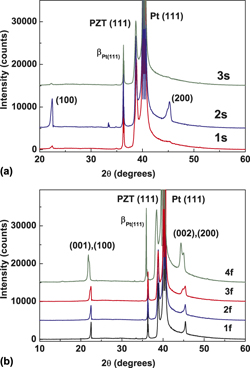No CrossRef data available.
Published online by Cambridge University Press: 02 May 2017

Two-step crystallization process based on a low-Pb-content seed layer is proposed to form PZT films by the chemical solution deposition. The first crystallization step was performed after the deposition from precursor solutions with 0 and 5 wt% Pb excess, which provides a low nucleation rate and the strong perovskite (111) orientation. The bulk film was obtained from solutions with a 30 wt% Pb excess, which ensures a high growth rate and eliminates formation of pyrochlore residuals. Some films with a fixed Pb excess were prepared for comparison. It is shown that the low-Pb-content seed layer can sufficiently enhance the texture of perovskite (111) grains thus providing the highest polarization magnitudes as compared to films prepared with the fixed Pb content. The lead content and the crystallization of the seed layer are found to affect the grain-boundary conduction, which, in turn, influences the polarization dependence of transient currents.
Contributing Editor: Paul Muralt
This paper has been selected as an Invited Feature Paper.